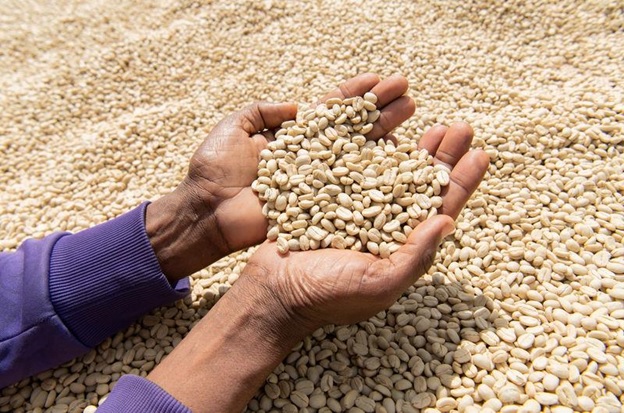
BY LAKACHEW ATINAFU
The sky rocketed cost of living and the ever increasing rate of inflation willy-nilly forced the nation to diversify options to secure foreign currency gaining’s increasing the volume of export items and affording quality product for the over sea market.
Coffee is the second demanded commodity next to petroleum in the global market. Ethiopia is one of the top coffee exporting countries ranking fifth in the world.
The land is botanic garden of a variety of coffee species with unique flavor at almost fertilizer free environment. The Ethiopian coffee which is organic and traceable is exported to about three continents-Asia, Europe and the United states.
Around 95 % of the Ethiopian coffee is produced by small holder farmers who work in their own farms and sell their products to middlemen. These intermediaries are widely suspected of short changing them on the huge profit margins.
The multi-million Dollar coffee business constitutes substantial percent of Ethiopia’s foreign exchange. However, the performance of Ethiopia’s export trade and the beneficiary of growers have been tempted under various circumstances. Illicit trade and contraband along with the failure of well promoting the product are posing potential challenges.
Even though Ethiopia has improved practices and made important progress all along its coffee value chain, its coffee farmers lag behind. Improved coffee plant varieties remain out of reach for too many farmers, the adoption of better processing techniques has been slow, and the rising potential for disease and weather shocks due to climate change is leaving farmers increasingly vulnerable.
However, over the few preceding years, the country registered huge export volume and reaped substantial profit. Apart from exporting coffee as a commodity, the country host Oscar of the coffee world, coffee Olympic formally called “Cup of Excellence” and the coffee sold at staggering price.
To explicate, in the first cup alone, Coffee from Nigusie Gemeda of Sidama, region received the highest price. The US company coffee at Intelligentsia bought the second highest coffee that belongs to Rumudamo Coffee PLC from Sidama at USD 108 (ETB 3672) per pound. The third highest price went to Testi Trading PLC at USD 66.60 (ETB 2264) per pound sold to black Gold Coffee Co. Ltd from Taiwan.
The nation earned USD 426.15 million from 20,438 tons of coffee shipped in the first three months of 2022/23 fiscal year, the Ethiopian Coffee and Tea Authority (ECTA) reported.
The revenue figure has shown a 30.27 % (or USD 27.30 million) jump compared with the amount secured in the same months last year
Germany ranks top with a share of 21 % of the revenue was and it has been the top destination for Ethiopian coffee in the three-month period this year.
Saudi Arabia (over 11 %) and Belgium (11 %) took second and third positions, respectively.
According to ECTA’s report, Ethiopia exported 14,934.75 tons of coffee to Germany and earned USD72.05 million.
Saudi Arabia also bought 8,991.94 tons for USD 45.54 million. More than 6,981 tons of coffee was also shipped to Belgium, fetching USD 44.56 million.
The US, the UAE, South Korea, China, Japan, Italy, and France consequently made up the remaining ECTA’s top 10 destination rank.
Countries in the top ten bought 82 %of the total volume and 82 % of total revenue of Ethiopia’s three-month coffee export.
Ethiopia is Africa’s largest exporter of coffee Arabica, and relies on earnings from the crop as a major source of foreign exchange.
Its officials aim to ship 360,000 tons of coffee to international market and secure USD 1.8 billion during the current 2022/23 fiscal year amid lower global coffee output forecast.
From October 2022 to September 2023 Ethiopia’s coffee exports are anticipated to increase to a 4.72 million bags, a record (280,560 metric tons – MT) from 282,000 MT the previous year, says a new report.
During this period, Ethiopia is expected to produce 8.25 million of 60-kilogram bags of coffee (495,000 MT), according to the report released a few weeks ago by United States Department of Agriculture.
More than 15 million smallholder farmers and other industry participants rely on coffee as their primary source of income in Ethiopia. Last Ethiopian budget year 2021/22, Ethiopia’s coffee exports totaled 4.70 million bags (282,000 MT).
Ethiopia is the world’s third-largest Arabica coffee producer and the greatest producer of coffee in Africa as of 2022, with a production that has slowly increased from 6 million to over 8.15 million bags in the past ten years. The coffee seedling that was recently planted and grew for five to ten years is now producing.
The production of coffee is anticipated to increase by 100,000 bags in 2022–2023 to 8.25 million bags (495,000 MT), assuming favorable weather, low insect and disease pressure, and sufficient rain.
The increased yields seen in the coffee producing belts, particularly in the southern and western regions, as well as the introduction of new trees for harvesting are the key causes of the increase in production volume.
Due to Coffee Berry Disease (CBD), coffee experts are also advising coffee farmers to implement all feasible phytosanitary measures, such as regular field monitoring to uproot and burn infected coffee trees CBD.
Sun-drying and wet processing are the two most popular coffee processing techniques. Currently, 20–30 percent of Ethiopian coffee is washed, and 70–80 percent is unwashed or sun-dried. In many areas, including the United States where consumers prefer “cleaner” cleaned coffee. Besides, unwashed coffee is sold for less money.
Ethiopia opened a cutting-edge coffee training facility in June 2021 to provide practice-based training that is modular in nature with the goal of improving the sustainability and value chain in the nation’s coffee sector. The facility is housed on the grounds of the Ethiopian Coffee and Tea Authority (ECTA) in Addis Ababa.
The facility offers training courses on the principles of coffee, processing, drying, and storing, as well as trade and equipment maintenance.
Documents further insisted that when Ethiopia exports coffee, there are four criteria that are taken into account: Certification (e.g., Fair-trade), Coffee grade and coffee cupping tests.
Geographical origin: from well-recognized geographical location in particularly Harar and Yirgacheffe.
Post-harvest treatment: sun dried or washed coffee. These high-quality coffees make up an estimated 25 % of export quantities and are occasionally referred to as specialty coffee.
Consumption: Ethiopians are among the continent’s biggest coffee drinkers, and the trend there is steadily increasing. 3.5 million bags of domestic coffee will be consumed in mid year 2022/23, according to forecasts (210,000 MT).
The majority of coffee bought on the local market was either rejected or did not fulfill the requirements set by the Ethiopian Commodity Exchange (ECX) for export quality.
However, for Arabica coffee, local prices are typically greater than those found elsewhere. Ethiopians’ social and cultural lives depend heavily on coffee.
Due to better export coffee prices over the past two years, coffee prices on the local market are rising annually.
Around 5 % of coffee production is anticipated to be diverted to the black market and cross-border trade in 2021/22, with the remaining 42 % going to the domestic market.
The remaining 58 % is directed toward the export market, with 80–85 % of that going through the ECX, 5–10 % going directly through cooperatives, and the remaining 5 % going through commercial farms.
Only in January 2022, Ethiopia sold about 11,200 bags (672 MT) of coffee online during the launch of Ethiopian coffee brands on China’s largest E-commerce platform, Alibaba (Tmall Global), as a result of collaboration with the Government of Ethiopia and the United Nations Economic Commission for Africa (ECA
The Ethiopian Herald 11 December 2022





